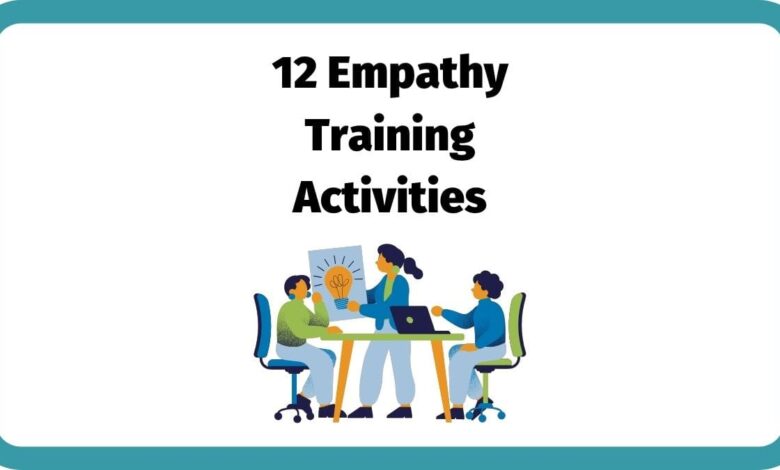12 Empathy Training Activities for Workplace Trainers


Empathy is an invaluable attribute that can really help work teams to be stronger, and so running empathy-related workshops can be a great idea.
With this in mind, these 12 empathy training activities for the workplace and empathy exercises for teams are free for you to use.
Use them to train colleagues on how to tune into one another’s feelings, how to avoid misunderstandings, strengthen workplace emotional intelligence, and collaborate more effectively.
Each exercise is short, simple to set up, and flexible enough to slot into a wider communication or leadership programme.
Why Empathy at Work Matters
Empathy isn’t just a “nice to have” between colleagues and between managers and their team. Empathy can help drive real business results.
Teams with high empathy tend to experience better communication, stronger collaboration, and fewer conflicts. It also boosts psychological safety, which is a key factor in innovation and retention.
Empathy and emotional intelligence go hand in hand, forming the foundation of compassionate communication that reduces misunderstandings and builds trust in teams.
Research shows that emotional intelligence and empathy are key drivers of employee engagement and performance, making them essential components of any effective workplace training program.
What Are the Best Empathy Training Activities for the Workplace?
If you’re short on time, here are five powerful empathy building activities and team-based empathy exercises you can use right away to foster emotional connection and team trust:
- Perspective-Swap Roleplay
- Empathy Mapping Sprint
- Story Exchange
- Spot-the-Emotion Clip
- Empathy Circle
The Empathy Training Activities
1. Perspective‑Swap Roleplay
Objective: Learn how to see a familiar situation through somebody else’s eyes.
Time Needed: 25 to 30 minutes
How to run the activity
- Ask participants to join up into pairs, and then give each person a short workplace scenario – for example, an unhappy manager with a missed deadline. In the pair, one person will play a role such as the manager, and the other person the employee. They should spend two minutes writing down how they might feel about the situation.
- After the three minutes, ask them to swap roles (the manager becomes the employee and vice‑versa) and they spend two minutes again jotting down how their “new” character feels.
- Roleplay the conversation for about five minutes.
- Pause and invite pairs to talk through what surprised them or felt awkward.
- Swap back and let them replay the same scene in their real roles to see what changes.
Debrief questions
- Which feelings did you notice only after stepping into the other role?
- How might this fresh insight change your next real conversation?
2. Empathy Mapping Sprint
Objective: To build a rounded picture of how a teammate experiences their day.
Time Needed: 30 minutes
How to run the activity
- Split participants into groups of three or four and hand out an Empathy Map (Think & Feel / See / Hear / Do).
- Supply a brief persona – e.g., new remote hire juggling time zones.
- Teams fill each quadrant with sticky notes; push them to include at least five ideas per box.
- Ask groups to highlight the top two pain points they uncovered.
- Finish by brainstorming one simple action that would make that person’s week easier.
Debrief questions
- What assumptions did you catch yourself making?
- Which small action could you test tomorrow?
3. Story Exchange
Objective: Deepen trust by retelling a colleague’s real experience in the first person.
Time Needed: 35 to 40 minutes
How to run it
- Put participants into pairs and give them three minutes each to share a work moment where they felt unheard (keep it light; no confidential dramas).
- The listener then retells the same story as if it were their own, matching tone and emotion.
- Swap roles and repeat.
- Invite pairs to discuss what it was like to “loan” their story to someone else.
- Bring everyone together to surface key themes or surprises.
Debrief questions
- Did the listener capture the heart of your story?
- How did it feel to speak through another person’s voice?
4. Spot‑the‑Emotion Clip
Objective: Help participants sharpen their ability to read emotional cues quickly.
Time Needed: 20–25 minutes
How to run the activity
- Play a one‑minute muted video of a workplace interaction (YouTube ads work well).
- In small groups, list the emotions you think are present and the non‑verbal clues that signal them.
- Replay the clip with sound to check guesses.
- Discuss how misreading cues could derail a live meeting.
- Optional extra: ask volunteers to replay the scene live and exaggerate the body language for fun.
Debrief questions
- Which clues were hardest to read without audio?
- How confident are you in spotting similar cues on Zoom?
5. Crafting Empathetic Replies
Objective: A chance to practice wording that validates feelings before offering help.
Time Needed: 20 minutes
How to run the activity
- Share five common grumbles, such as “I’m swamped with emails”.
- Participants write a one‑sentence response that a) recognises the emotion, b) shows support.
- Collect answers on a flipchart and vote for the most genuine‑sounding versions.
- Compare them to bland or dismissive replies so the contrast is obvious.
- Challenge the group to reuse their favourite phrase in real life within 24 hours.
Debrief questions
- What wording made a response feel sincere?
- How might culture or personality shape what sounds genuine?
6. Silent Listener
Objective: Experience the power of non‑verbal feedback.
Time Needed: 15–20 minutes
How to run the activity
- Person A speaks for two minutes about a mild frustration; Person B listens in silence, nodding and using eye contact only.
- Switch roles.
- Ask each speaker to rate on a scale of 1‑5 how “heard” they felt.
- Discuss which body‑language cues mattered most.
- Repeat but allow the listener to add brief verbal summaries (“So you’re feeling…”) and compare scores.
Debrief questions
- Did silence make you feel supported or uneasy?
- Which gestures conveyed the most empathy?
This exercise helps develop core active listening strategies that are crucial in feedback and active listening activities, coaching skills development, and everyday conversations.
>> For downloadable resources, check out our Active Listening Training Materials.
7. Empathy‑First Problem Solving
Objective: Approach tricky issues by naming feelings before fixes.
Time Needed: 30 minutes
How to run the activity
- Present a challenge – e.g. team member persistently late to stand‑ups.
- In trios, spend two minutes listing how each stakeholder might feel; no solutions yet.
- Only after feelings are captured do teams brainstorm fixes.
- Groups roleplay the preferred approach and gather feedback.
- Capture any wording that worked particularly well on a shared board.
Debrief questions
- How did naming emotions first change the tone of solutions?
- Which fix felt most respectful to everyone involved?
8. Gratitude Chain
Objective: Boost morale by making appreciation visible.
Time Needed: 25 minutes
How to run the activity
- Hand each person two sticky notes.
- Note something you appreciate about the person on your left and stick it on their desk or laptop.
- Read the notes aloud in a circle, giving receivers a moment to respond.
- Optionally, collect all notes and create a “Gratitude Wall” poster for the office or intranet.
- Encourage participants to keep the chain going informally after the session.
Debrief questions
- How did receiving public praise feel?
- What happens to team culture when gratitude is normalised?
This activity naturally encourages small acts of kindness that build a stronger, more compassionate team culture.
9. Rewrite the Conflict
Objective: Revisit a past disagreement and script a more empathetic version.
Time Needed: 35–40 minutes
How to run the activity
- Ask everyone to privately jot down a brief conflict they had at work (no names needed).
- Write the original dialogue as a quick script.
- Next, rewrite the same scene, adding empathetic statements and curious questions.
- Volunteer pairs act out the new versions.
- Discuss what shifted in tone, outcomes, or body language.
Debrief questions
- Which line of dialogue created the biggest positive shift?
- What will you try differently next time a conflict sparks?
10. Seven‑Day Empathy Challenge
Objective: Turn empathy into a daily micro‑habit.
Time Needed: Ongoing for one week
How to run the activity
- Provide a checklist of small acts (e.g., ask “How are you—really?”, offer help unprompted).
- Participants aim to tick one box each workday.
- Keep momentum via a shared chat thread where people post brief reflections.
- At week’s end, gather for coffee and share the biggest insights.
- Encourage teams to set a new target for the following month.
Debrief questions
- Which tiny action had the greatest impact on someone else?
- How hard was it to remember empathy when busy?
11. Emotion‑Wheel Dialogue
Objective: Expand emotional vocabulary and comfort discussing feelings.
Time Needed: 25–30 minutes
How to run the activity
- Provide each pair with an emotion wheel print‑out.
- One person shares a recent situation; together, pinpoint three emotions on the wheel that best fit.
- Swap roles.
- Compare how often people defaulted to “tired/stressed/fine” versus richer words.
- Challenge pairs to use two new emotion terms in meetings this week.
Debrief questions
- Did the wheel help you drill deeper than “I’m okay”?
- Which new term will you try using more often?
12. Empathy Circle
Objective: Experience active listening in a safe, structured format.
Time Needed: 40–45 minutes
How to run the activity
- Sit in a circle. Person A has four minutes to speak about any work topic while Person B (the reflector) mirrors back the essence of what they said.
- Person A confirms or corrects the reflection.
- Roles move clockwise until all have spoken and reflected.
- Remind the group of ground rules: respect, confidentiality, and no advice.
- Close with a quick round asking what it felt like to be heard so attentively.
Debrief questions
- What did you notice in your body when being fully heard?
- How can you bring that quality of listening to everyday chats?
How to Use These Activities
These empathy training activities for the workplace are designed to be flexible, engaging, and easy to facilitate in workplace training sessions.
You can run them as part of a larger communication or leadership training session using our practical workplace communication guides.
Tips for successful delivery:
- Start light – Open with low-stakes activities to build trust before diving deeper.
- Mix and match – Choose 2–4 exercises that suit your group’s needs and time.
- Debrief well – Always leave time for reflection to deepen learning.
- Repeat often – Empathy builds over time; consider running these regularly.
Whether you’re a trainer, HR professional, or team lead delivering teaching empathy activities, these tools help create a more connected, understanding, and resilient workplace culture.
These empathy exercises also complement the emotional intelligence activities you can use to further strengthen interpersonal understanding for your employees or those you are providing training for.
Final Thoughts
Empathy isn’t something we talk our way into—it grows through repeated, concrete practice. Pick two or three of the activities above for your next team day and see how the mood shifts.
For ready-to-use resources, explore our full range of communication skills training materials.
Using empathy training activities for the workplace regularly can help shift culture, build emotional safety, and enhance team cohesion long-term.
By embedding empathy into your daily interactions, you’ll also boost team cohesion, helping people feel seen, valued, and motivated.


Why not take a glance at the Emotional Intelligence training materials for corporate trainers, or take a look at the full range of workplace training materials.





